During my trip to Wellington (FL) this past winter, I ran into Cian O’Connor. Ok, more like I saw him, made a bee-line to him, and pounced – inquiring, “Hi Cian, could you possibly spare a few minutes to share some advice and insights into your riding and training with me for my column with Phelpssports.com?” Without hesitation he replies, “Sure.” “Catch up with me after my competition tomorrow afternoon. I will be at the International Arena.” “Great,” I say. “And thanks!” 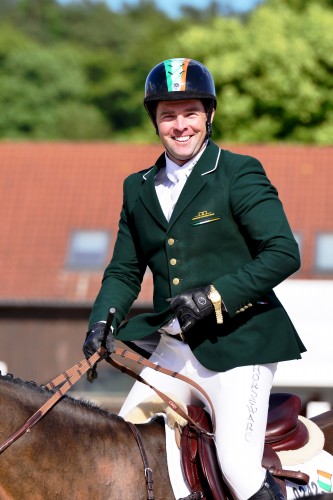 I started watching Cian after he won the bronze 2012 Olympic metal and subsequently learned that he had ridden a horse related to mine at one point. So as you can imagine, I was thrilled to be able to speak with him and gain insights from his perspective. So I did as told and met up with him the next day. A friend of mine recorded our conversation, but alas, high winds during taping made it difficult for me to hear some of our discussion. So I email him in late April, after the busy show season, and ask if he wouldn’t mind a supplemental phone interview with me. “No problem,” he replies. So here I am a bit behind on my deadline, but the better for it. I hope you enjoy our conversation and learn as much from it as I did.
I started watching Cian after he won the bronze 2012 Olympic metal and subsequently learned that he had ridden a horse related to mine at one point. So as you can imagine, I was thrilled to be able to speak with him and gain insights from his perspective. So I did as told and met up with him the next day. A friend of mine recorded our conversation, but alas, high winds during taping made it difficult for me to hear some of our discussion. So I email him in late April, after the busy show season, and ask if he wouldn’t mind a supplemental phone interview with me. “No problem,” he replies. So here I am a bit behind on my deadline, but the better for it. I hope you enjoy our conversation and learn as much from it as I did.
It was really fun meeting you in Florida in February. I know you were quite busy then. What do you have coming up this spring and summer in Europe? (This was recorded in early May 2012.)
I am headed to Lisbon this weekend. My stable rider Ross Mulholland is competing in the Nations Cup on the Irish B team riding one of my horses, then myself and Nikki (Nicole Walker a Canadian young rider who owns Blue Loyd and who Cian coaches) are off to an international show in Germany, from there I will compete at a four star show in Fontainebleau in France. Then I will be at the Aachen show in Germany at the end of the month. So it’s a fairly busy four weeks on the road with shows and then we finish up in July with the Global Champions Tour and then at the Dublin horse show at the beginning of August for the Furusiyya Nations’ Cup.
Wow, that’s a lot of shows! Tell me – how do you prepare for such a grueling schedule?
I am quite fanatical about show jumping. It is not something you can drop and pick up – it’s 24/7. I spend a lot of time on my computer at my office looking at videos, new prospects, checking out results. And then there is also the business side – dealing with owners, sponsors, media and social media as well. I have quite an up-to-date website linked with Facebook and Twitter. All that stuff we do ourselves, so it’s fairly busy keeping all the balls in the air. There are other things happening in my life too. Myself and my wife, Ruth, have just moved into a beautiful property in County Meath (twenty-five miles from Dublin) where we have a fantastic house that sits on seventy acres, and we are also expecting our first baby in September.
Well congratulations on the baby – that is exciting! And the new home sounds amazing. Will you be taking on clients there?
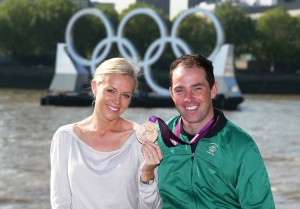
Yes, at some point. In the future I want to build a really nice equestrian facility there. My plan will be that students can come and train and we will be able to accommodate them and their horse onsite. I suppose while I am riding I really enjoy it, but what I am thinking is in the future, when I am not competing as much, this will be somewhat of a Training Centre of Excellence.
That sounds like a wonderful plan. Good luck with that.
Thank you
You mentioned when I interviewed you in Florida that the first thing you look for in a horse is “heart.”
Yeah.
What do you mean by that? How do you spot ‘heart’ in a horse?
I suppose it’s something that is quite hard to try them for. It is hard to know how courageous they are. Same goes for people! For it is only when they’re in trouble that you see the difference between the good ones and the average ones. It’s the person that can dig deep in the hard times and come out the far side. I actually had never tried Blue Loyd when I bought him, which is maybe a good thing as he is not overly big, and it would have been hard to judge his scope, but I had seen him so often with his previous rider that I just loved him. I loved his character and his attitude. I think that is half the battle when the horse loves his job.
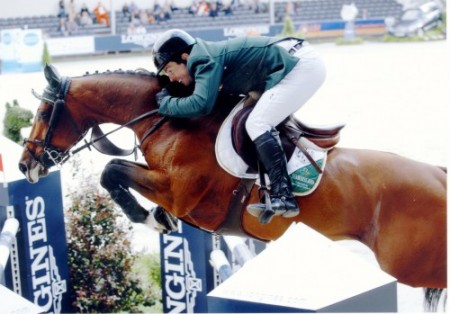
You had mentioned that they need to be an athlete too. Explain.
What I mean by an athlete is that there are so many horses that are good over one or two jumps – that’s what makes it so hard when you’re trying out a horse. The obvious horse is often not the best one. For example, when you watch a young horse class, we are all looking for the perfect technique and method over the fence – but if you watch a Grand Prix horse jumping, they very often are able to jump in an inverted shape while still using their back end. Finding good horses is a skill in itself and not necessarily the best riders make the best judges. I guess you develop an eye to spot potential but this gets fast tracked when you make some mistakes with your own money! I like to find a rough diamond – a horse that has not had a lot of mileage at a meter forty-five or a meter fifty, and is careful and honest. Then a good rider can take it to the next level pretty quickly. I have been successful with those kinds of horses. Horses that have experience and are just a division below breaking international. While there are some people that love to have horses with all the results, quite often those are the ones that have been used too much. So I tend to pick ones who are just about coming through – that aren’t too exposed.
That makes perfect sense. Have you found many?
I am looking all the time, in the last several years I have bought and sold several like that. I had an Irish horse called Larkhill Cruiser that I jumped on the Irish team and then sold to Abdullah Al Sharbatly from Saudi Arabia. Previously I had a horse called K Club Lady who I bought in Spain in the spring of 2010. She was jumping a meter fifty with a national Spanish rider and three months later we placed second in the five star Grand Prix in Switzerland. A month later she was on the winning Irish team at the nation’s cup in Aachen, Germany where she jumped two clear rounds. Following her success she was sold to the Ukraine. It would be nice to hold onto them, but my main business is buying and selling horses. Of course I get great enjoyment out of the competition side of things but ultimately this is a business and the owners/investors who partner with me on many of these acquisitions expect a return on their investment.
Right and I’ve heard it’s a tough business. Do you want to comment on that?
Yes. It’s a tough business for sure. You are constantly making big decisions and you have to be very straightforward about it. You go out with the best of intentions, you find and pick a good horse and you weigh it up. I always look at the down side, if it’s not good enough to make it, then what can I get for it? You know every horse has a job. Not everyone wants to be in the Olympics. There are many different levels obviously. If you buy a horse that is nice to ride, it can be of value to a junior rider. This also is a market. So I tend to go for those kinds of horses, as opposed to difficult horses that jump the moon because if they’re not good enough to make it all the way. Then they are hard to sell. So I think you must buy something that has commercial value. And you know we all make mistakes, too. Sometimes you don’t always pick the winner, but I’m a great believer in taking your first loss. If I bought a horse and I thought it was a superstar, I would obviously try to realize that. But if I felt it wasn’t good enough, I would just take my loss and move onto the next one. It is very important to keep moving; keep new horses coming in. For if you stay in the same place it’s hard to get motivated. I find that by going through numbers you find horses that come through.
Do you have a network of horse producers that you work with – stables and farms?
Yes, I suppose, but people know that I’m looking. On average, I will get twenty to thirty videos a week sent to me. The horse world is so small, which is good. Also with computers now you can do so much research online and watch the videos on YouTube, so you can really check a horse out so much better than you used to be able to do.
My horse is now with trainer Karen McCarthy. Do you recall Karen (she was on the Irish Team)? She said to say Hello.
I know Karen, yes! Lovely girl, I haven’t seen her in years.
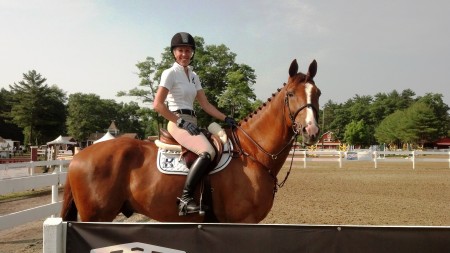
I have an Irish Sport Horse that I bought from an Irish trainer and now my current trainer is Irish. So I have all kinds of Irish connections going on!
You can’t get rid of the Paddys!
Yes, well it’s great! Good people and a lot of fun. And they really know the horse business. What I’ve noticed with Karen is the phenomenal care and treatment that she puts into her horses. Yes, top class. She has said that it “takes a village” to produce top level athletes – the best in grooming, training, feed, farrier and veterinary care, etc. You must have quite a team that you’ve assembled over the years.
Yes, it’s huge and I probably have a bigger team than most because I don’t skimp in any way on the background. I probably have one person to three horses and often more. I have a yard man, a yard manager, a head girl. Each rider to four horses has a groom. As well as myself, so it’s busy at Karlswood Stables, but if you do it right – you get the results.
With respect to horse care – is there a ‘silver bullet’ or is it really everything combined that produces top talent?
I think when it comes to health and fitness you start with the basics. When a horse comes to me I look at the feet first. I make sure the horse is well shod; I feel the farrier plays a huge role and quite often people underestimate their role. I frequently have them shod under X-ray with the vet. The old guys always said “no foot – no horse.” I can’t emphasize enough the importance of having a horse well shod. Good ground is really important as well, for the horse, working on a surface that’s conducive to keeping them in good shape. And often, too, what I’ve seen in other places is that they don’t give the horse enough work. They flat them for fifteen minutes and then they think that that’s work. Our horses go out four times a day, whether it’s for a hack around the farm for an hour, a lung, out to the paddock and then to get their flatwork. I think it’s important to develop really strong legs. For when you have their legs strong, it lessens their injuries. Injuries come from unfit horses that are pushed and their legs aren’t strong enough to carry them.
And when you think about it horses were meant to be out roaming the fields all day and cantering about. To be only let out for an hour or two a day is against their makeup.
That’s right and it’s depressing for them too to spend so many hours in a box.
You told me this winter that confidence in the number one factor in a rider. Can you explain?
You have to be resilient and not take to heart what people may say or think about you. There are going to be good days and bad days, and you have to dust yourself off after the bad days. I am very good at goal setting – working towards specific targets. Making sure those targets are achieved by being organized and leaving no stone unturned. So I suppose it’s the whole build up. Showing up at the arena for two minutes is the icing on the cake. What you see on the TV, the last bit, is the result of all the homework that is done before hand.
To that end, what would you say to me just getting into this sport as a complete novice in midlife and wanting to one day jump a Grand Prix?
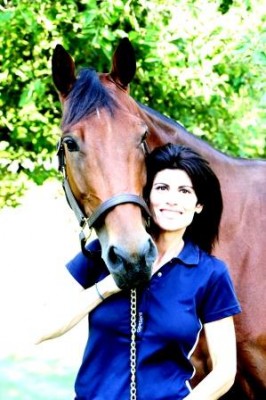
What I would say is that you have to set realistic targets along the way. One thing you want to be sure about is safety. You don’t want to set an objective for yourself that is dangerous. If your trainer feels you can work towards that goal and get there, there is no reason why, at whatever level you are jumping, that you can’t aim to do it particularly well. To sit in the correct way, the right number of strides between fences, work on getting inside the time allowed, and then eventually trying to go a little faster against the clock. It’s not the height that matters. When I’m teaching, I am more inclined to educate the riders to go well. For if you don’t care about doing it well –just drive on trying to get away with it, then I suppose one day when you jump big you can’t repeat it because you haven’t learned the system to be able to repeat it. So I prefer that someone stays jumping at a smaller level and does it right, and then progresses in stages to go onto a meter twenty, thirty, small Grand Prix, etc. But if you just point and shoot, then it’s a Kamikaze job, and you will never learn to do it again.
Excellent advice. Do you think it would be possible for me to have a lesson with you one day?
Of course! I would be delighted to help you!
That would be fantastic, perhaps at your Training Centre of Excellence one day?
No problem.
Thanks Cian and best of luck with the upcoming show schedule, baby and new home!
Thank you!
There you have it, fantastic advice and training strategies from Olympic medalist Cian O’Connor that I, for one, will certainly take to heart.




